1. THE FLOUR The quality of the pizza depends on the flour. Gabriele Bonci believes the only flour worth working with is organic stone-ground flour (such as Burratto flour by Mulino Marino). "Making pizza is like making art. Before you have the dough, you have the flour and then you add water and then the art takes shape."
2. THE YEAST For best results, Bonci advises home chefs to use dried yeast and to use it sparingly. "You need to have patience. The dough has to rise for at least 24 hours. That is very important. This makes the pizza lighter, airier and easier to digest."

Make your own ... margherita.Credit: Edwina Pickles
3. THE KNEADING Bonci says this step is crucial to the success of the pizza. "You need to treat the dough like a woman's body. It is a living thing. You need to have a rapport with it and understand how it should feel - springy and not sticky - and, most importantly, not overwork it." (See recipe method above for more details).
4. KNOW YOUR OVEN Bonci says a good pizza chef has an intimate relationship with their oven. "If a recipe says cook the dough for 15 minutes, you need to know that is just a guide. If you want a pizza to be proud of, you have to know how that dough will respond in your oven." The oven should be pre-heated to its hottest setting.

True pizazz ... Gabriele Bonci and Lucio De Falco.Credit: Marco Del Grande
5. USE QUALITY INGREDIENTS Despite being akin to an alchemist when it comes to pairing unusual combinations, Bonci suggests home pizza makers should start out by "keeping it simple and only use quality, seasonal ingredients".
Pizza dough recipe
1kg of flour (try Mulino Marino*)
7g sachet dried yeast
700ml warm water
20g sea salt
45ml extra virgin olive oil
1. Using a wooden spoon, mix the flour, yeast and water in a large bowl. When it is almost mixed and the lumps are mostly gone, add the salt, then the oil. It will seem very wet. The wetter the dough, the better.
2. Flip the dough onto a lightly floured surface and work it gently by folding the dough in half, over itself, towards you. Grab the dough by the two corners facing you and pick it up like an envelope, turn it 90 degrees and place it back on the floured board. Repeat this motion a few times. It will seem very sticky at first, but when you get the hang of it, it gets easier.
Note: The time spent doing this varies according to the hand temperature of the person kneading. The core temperature of the dough should not exceed 24 degrees.
3. Place the dough back in a lightly oiled bowl and let it rest for another 15 minutes. Repeat step 2 two or three more times. Don't knead.
4. When done, cover very tightly in the bowl and let it rise in the fridge for 24 hours.
5. Take out of the fridge and let it reach room temperature.
6. Preheat an electric oven to its hottest setting. If using a wood-fired oven, the oven needs to reach between 400C and 450C.
7. Lightly flour a board and follow the steps in the video below to get your dough into the oiled pan. Be very gentle, massage the dough and seek to retain the pockets of air that have formed overnight.
See www.elizabethminchilliinrome.com/2011/01/making-pizza-dough-with-gabriele-bonci.html for video.
* Mulino Marino flour is available from lario.com.au.